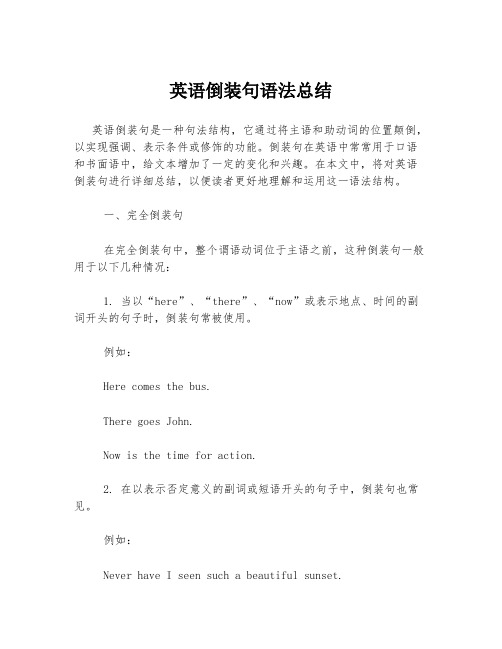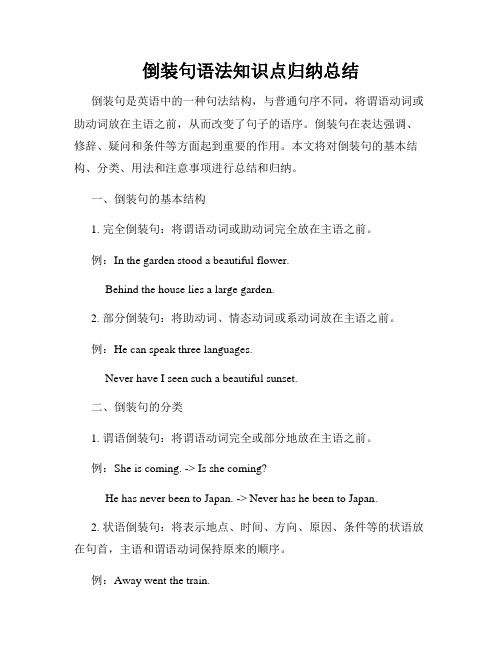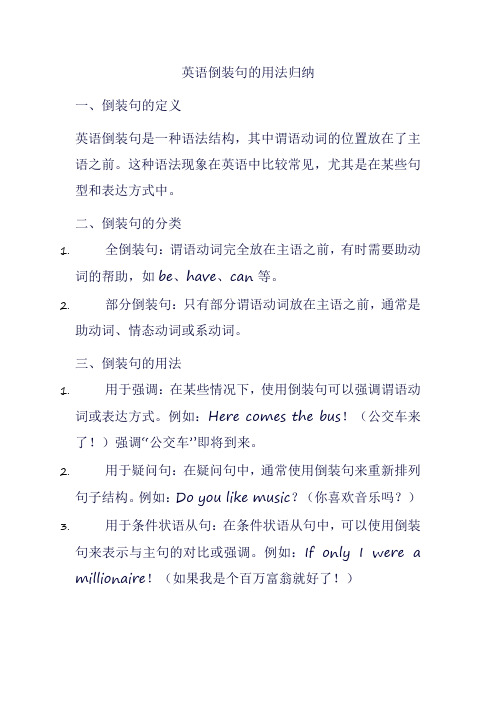英语语法归纳总结及倒装句
英语倒装句语法点

倒装、强调和省略装、强调和省略倒装 Inversion英语的一般语序(自然语序Natural Order)为:主语 + 谓语动词 + 宾语(或表语) + (状语等附加成分)。
有时为了语法上或修辞上的需要而改变这种语序。
一、语法倒装1. 句首是由某些表示地点状语的副词开头,或者方位副词、介词短语放在句首时,主谓全部倒装(Full Inversion)。
比如:here, back, down, off, in, up,hence, then, thus, often, so,out, up, away, on等,通常只用于一般现在时和一般过去时,谓语动词常用be, come, go, lie, run。
主语为主语必须是名词,如果主语是人称代词则不能完全倒装。
Here is your letter. 这是你的信。
Down came the rain. 下雨了。
Hence comes the name magnet. 由此得名“磁铁”。
Into the sky went the plane. 飞机飞向天空。
Away went the girl to the school! 这个女孩到学校去了!Off goes the woman! 那个女人走了!2. 以there开头,表示“….有….”, “There+be+主语”结构;在正式文体中,当主语不明确是一个很长的名词短语时,用“there+不及物动词+主语”结构。
There are more important matters we need to discuss.我们有很多重要的事情需要讨论。
There entered a strange little man.走进来一个奇怪而身材矮小的人。
3. 主语 + live, stand, lie, sit 等动词+(介词)地点状语的结构中常采用倒装语序。
正常语序:An old temple stands at the top of the hill.倒装语序:At the top of the hill stands an old temple.山顶上有座古庙。
倒装句语法知识点归纳总结

倒装句语法知识点归纳总结1. 在以no sooner, hardly, at no time, little, seldom, never, not only等否定词或者否定短语引导的句子中,主语和谓语部分需要倒装。
例如:- No sooner had I arrived at the station than the train left.- Hardly did we start our journey when the rain began to fall.2. 在表示地点或者时间的介词短语放在句首时,需要进行倒装。
例如:- On the corner stood a tall and handsome man.- Under the table lay a sleeping cat.3. 在表示方向的副词放在句首时,需要进行倒装。
例如:- Down the street came a group of excited children.- Up the hill ran the little girl.4. 在以“so+形容词/副词+助动词/情态动词+主语”结构引导的句子中,需要进行倒装。
例如:- So quickly did she finish the test that she had time to review her answers.5. 在以“such+名词+从句”结构引导的句子中,需要进行倒装。
例如:- Such was his love for her that he would do anything for her.总的来说,倒装句的使用可以增强语气,突出句中的某些部分,使句子更具有表现力和影响力。
在写作和口语表达中,适当地运用倒装句可以提高语言的表达能力和水平。
需要注意的是,在使用倒装句时,对于不同的语法规则和用法要有清晰的认识和理解,以避免出现错误的倒装句结构,从而影响句子的意思和表达效果。
英语倒装句语法总结

英语倒装句语法总结英语倒装句是一种句法结构,它通过将主语和助动词的位置颠倒,以实现强调、表示条件或修饰的功能。
倒装句在英语中常常用于口语和书面语中,给文本增加了一定的变化和兴趣。
在本文中,将对英语倒装句进行详细总结,以便读者更好地理解和运用这一语法结构。
一、完全倒装句在完全倒装句中,整个谓语动词位于主语之前,这种倒装句一般用于以下几种情况:1. 当以“here”、“there”、“now”或表示地点、时间的副词开头的句子时,倒装句常被使用。
例如:Here comes the bus.There goes John.Now is the time for action.2. 在以表示否定意义的副词或短语开头的句子中,倒装句也常见。
例如:Never have I seen such a beautiful sunset.Not only is she talented, but she is also kind-hearted.3. 在以“only”开头修饰状语从句的句子中,倒装句也经常使用。
例如:Only when you face your fears can you overcome them.Only in this way can the problem be solved.二、部分倒装句部分倒装句中,只将助动词或情态动词放在主语之前,而将主语与谓语动词的位置维持原状。
部分倒装句常用于以下几种情况:1. 当以否定副词“never”、“seldom”或“rarely”开头时,部分倒装句可以被采用。
例如:Never have I been so happy.Seldom does he complain about anything.2. 在以“so”或“such”引导的句子中,为了表达强调,可以使用部分倒装句。
例如:So tired was she that she fell asleep on the couch.Such is the power of love that it can conquer all obstacles.3. 在以“not”开头的句子中,为了增强否定的语气,常常使用部分倒装句。
倒装句语法知识点归纳总结

倒装句语法知识点归纳总结倒装句是英语中的一种句法结构,与普通句序不同,将谓语动词或助动词放在主语之前,从而改变了句子的语序。
倒装句在表达强调、修辞、疑问和条件等方面起到重要的作用。
本文将对倒装句的基本结构、分类、用法和注意事项进行总结和归纳。
一、倒装句的基本结构1. 完全倒装句:将谓语动词或助动词完全放在主语之前。
例:In the garden stood a beautiful flower.Behind the house lies a large garden.2. 部分倒装句:将助动词、情态动词或系动词放在主语之前。
例:He can speak three languages.Never have I seen such a beautiful sunset.二、倒装句的分类1. 谓语倒装句:将谓语动词完全或部分地放在主语之前。
例:She is coming. -> Is she coming?He has never been to Japan. -> Never has he been to Japan.2. 状语倒装句:将表示地点、时间、方向、原因、条件等的状语放在句首,主语和谓语动词保持原来的顺序。
例:Away went the train.In the distance could be seen a tall tower.3. 主从倒装句:主句和从句中的主语-谓语结构进行倒装。
例:Not until she finished her homework did she go to bed.Only when the rain stopped could we go outside.三、倒装句的用法1. 强调句:通过倒装句,可以将句子的某一部分进行强调,常用的结构是完全倒装句和部分倒装句。
例:Not only did he win the game, but he also broke the record.Under no circumstances should you touch the red button.2. 疑问句:直接将谓语动词或助动词放在主语之前形成疑问句。
高中英语知识点归纳倒装句的用法总结

高中英语知识点归纳倒装句的用法总结高中英语知识点归纳:倒装句的用法总结倒装句是英语语法中的一种特殊语法结构,常见于各种语言形式中。
倒装句通常在句子中,把谓语动词放在主语之前,从而改变了正常语序。
在英语学习中,倒装句是一个重要的知识点,掌握了它的基本用法,可以使我们的表达更加地准确、得体。
本文将对高中英语学习中与倒装句有关的知识进行归纳和总结,以便同学们更好地掌握和运用。
一、完全倒装句完全倒装句是指把整个谓语动词放在主语之前,常用于以下几种情况:1.以副词或介词词组开头的句子:- Never have I seen such a beautiful sunset. 我从未见过如此美丽的日落。
- In front of us stood a tall building. 在我们面前矗立着一座高楼。
2.以表示否定意义的副词开头的句子:- Not only did she forget my birthday, but she also didn't apologize. 她不仅忘记了我的生日,而且也没有道歉。
3.以表示“只有、仅仅、唯一”等意义的副词或词组开头的句子:- Only by working hard can you achieve your goals. 只有通过努力工作,你才能实现自己的目标。
4.以表地点的副词或介词短语放在句首,句子的主语为there时:- There is a cat under the table. 桌子下有一只猫。
- Here comes the train. 火车来了。
二、部分倒装句部分倒装句是指把助动词放在主语之前,常用于以下几种情况:1.以表示否定的词或短语开头的句子,包括never、not、seldom、hardly等:- Never have I seen such a talented musician. 我从未见过如此有天赋的音乐家。
2.以表示“只有、仅仅、唯一”等意义的副词或词组开头的句子,包括only、hardly等:- Only when the sun sets can we see the stars in the sky. 只有太阳下山后,我们才能看到天空中的星星。
英语倒装句的用法归纳

英语倒装句的用法归纳一、倒装句的定义英语倒装句是一种语法结构,其中谓语动词的位置放在了主语之前。
这种语法现象在英语中比较常见,尤其是在某些句型和表达方式中。
二、倒装句的分类1.全倒装句:谓语动词完全放在主语之前,有时需要助动词的帮助,如be、have、can等。
2.部分倒装句:只有部分谓语动词放在主语之前,通常是助动词、情态动词或系动词。
三、倒装句的用法1.用于强调:在某些情况下,使用倒装句可以强调谓语动词或表达方式。
例如:Here comes the bus!(公交车来了!)强调“公交车”即将到来。
2.用于疑问句:在疑问句中,通常使用倒装句来重新排列句子结构。
例如:Do you like music?(你喜欢音乐吗?)3.用于条件状语从句:在条件状语从句中,可以使用倒装句来表示与主句的对比或强调。
例如:If only I were a millionaire!(如果我是个百万富翁就好了!)4.用于让步状语从句:在让步状语从句中,可以使用倒装句来表示转折关系。
例如:Try to find a way to solve the problem!(试着找到解决问题的方法!)5.用于虚拟语气:在虚拟语气中,可以使用倒装句来表示与实际情况相反的情况。
例如:If I were you,I would go to the party.(如果我是你,我会去参加派对。
)6.用于某些固定句型:有些固定句型要求使用倒装句。
例如:“Hardly had she sat down when the phone rang.”(她刚坐下电话就响了。
)7.表示惊讶、感叹、讽刺等情绪时也可以使用倒装句。
例如:How could you do such a thing!(你怎么能做出这种事!)四、倒装句的用法归纳总结1.英语倒装句是一种语法结构,主要有全倒装句和部分倒装句两种类型。
2.使用倒装句可以强调谓语动词或表达方式,也可以用于疑问句、条件状语从句、让步状语从句和虚拟语气等语法结构中。
英语倒装句用法经典总结
英语倒装句用法经典总结1.完全倒装句:主语和谓语动词完全倒置。
如:- Never have I seen such a beautiful sunset.(我从未见过如此美丽的日落。
)- Little did he know about the problem.(他对问题一无所知。
)2.部分倒装句:只将助动词或情态动词和主语进行倒置。
如:- Can you swim?(你会游泳吗?)- Should you have any questions, please let me know.(如果你有任何问题,请告诉我。
)3.如果句子以表示地点的副词或介词短语开头,也需要进行倒装。
如:- On the top of the mountain stood a small cabin.(在山顶上有一间小木屋。
)4.如果句子以表示否定意义的副词或介词短语开头,也需要进行倒装。
如:- Under no circumstances will I allow that to happen.(无论如何,我都绝不容许那种事情发生。
5. 在条件句中,如果主语和谓语动词之间使用“had”,“were”或“should”时,需要进行倒装。
如:- Had I known it earlier, I would have prepared better.(要是早知道这个,我会准备得更好。
)- Were I you, I would apologize.(要是我是你,我会道歉。
)以上是英语倒装句的几种常见用法,不同的倒装句用法可以根据具体的语境和语法规则进行灵活运用。
倒装句语法点总结
倒装句语法点总结一、啥是倒装句呢?哎呀,倒装句啊,就像是句子在玩倒立一样。
正常的句子结构就像咱们正儿八经站着,主谓宾或者主系表的顺序规规矩矩的。
可倒装句呢,它就把这个顺序给打乱了,要么是谓语跑到主语前面去了,要么是其他成分跑到不该在的位置啦。
比如说“Here comes the bus”,正常咱们会说“The bus comes here”,这就是倒装句,把“comes”这个谓语提到主语“the bus”前面了,是不是很有趣呀?就像句子在调皮捣蛋呢。
二、倒装句的种类1. 完全倒装完全倒装就是整个谓语都跑到主语前面去了。
像“Out rushed the children”,你看,“rushed”这个谓语和它的修饰词“Out”一起跑到“the children”前面了。
这种情况常常出现在一些表示方位、地点的副词或者介词短语放在句首的时候,句子就像被一股神秘力量给颠倒过来了。
2. 部分倒装部分倒装呢,就是只把助动词、be动词或者情态动词放到主语前面。
比如说“Only in this way can we solve the problem”,这里“can”这个情态动词就跑到“we”前面去了,而真正的谓语动词“solve”还在后面呢。
这种倒装经常出现在一些表示否定意义的词或者短语放在句首的时候,像是“Never”“Hardly”之类的。
三、倒装句的作用1. 强调作用倒装句可以用来强调某个部分。
就像刚刚说的“Only in this way can we solve the problem”,它强调了“in this way”这个方式,意思就是只有用这种方式我们才能解决问题。
如果是正常语序“We can solve the problem only in this way”,强调的感觉就没那么强烈啦。
2. 平衡句子结构有时候句子太长了,主谓宾或者主系表的顺序会让句子看起来头重脚轻的。
倒装句就可以来救场啦。
(完整版)高中英语语法倒装总结全
倒装句倒装的两种考法:1. 放在单项选择题中,考查考生的倒装语法知识是否熟练掌握;2. 放在完形填空和阅读理解中,设置理解障碍。
倒装的两种形式:1. 完全倒装:将整个谓语动词提到主语前。
2. 部分倒装:即半倒装,将谓语的一部分即助动词提到主语前。
一、完全倒装1】表方位的副词here, there 或out, in, up, down, away, off, over, back等标志词放在句首,句子用完全倒装。
【翻译句子】(1)车来了。
Here comes the bus.(2)铃响了。
There goes the bell。
(3)孩子们冲出来了。
Out rushed the children.(4)那个男孩离开了。
Away went the boy.【疑难】Here it is.In she came.Away he went。
【疑难剖析】当主语是人称代词时,主谓语序不变.2】地点状语放在句首且谓语动词为come, live, lie, go, sit, stand等时用完全倒装。
【完成例句】(5)河的南面有一家小工厂。
In south of the river lies a small factory.(6)山谷里传来一声喊叫。
From the valley came a cry。
3】 such, the following等放句首时,句子要完全倒装。
【翻译句子】(7)Such are the facts. 情况就是如此。
(8)生活就是这样。
Such is life.(9)The following is the answer to the question。
这个问题的答案如下。
4】There lie / exist / stand / live +主语+…是there be 句型的变式【翻译句子】(10)山顶上有一幢高楼.There is a tall building on the top of the mountain.(11)山顶上耸立着一座古塔。
初中英语语法总结--倒装句
全部倒装是只将句子中的谓语动词全部置于主语之前。
此结构通常只用与一般现在时和一般过去时。
常见的结构有:1) here, there, now, then, thus等副词置于句首, 谓语动词常用be, come, go, lie, run。
There goes the bell.Then came the chairman.Here is your letter.2) 表示运动方向的副词或地点状语置于句首,谓语表示运动的动词。
Out rushed a missile from under the bomber.Ahead sat an old woman.注意:上述全部倒装的句型结构的主语必须是名词,如果主语是人称代词则不能完全倒装。
Here he comes. Away they went.部分倒装是指将谓语的一部分如助动词或情态倒装至主语之前。
如果句中的谓语没有助动词或情态动词,则需添加助动词do, does或did,并将其置于主语之前。
1) 句首为否定或半否定的词语,如no, not, never, seldom, little, hardly, at no time, in no way, not until…等。
Never have I seen such a performance.Nowhere will you find the answer to this question.Not until the child fell asleep did the mother leave the room.当Not until引出主从复合句,主句倒装,从句不倒装。
I have never seen such a performance.The mother didn't leave the room until the child fell asleep.典型例题1) Why can't I smoke here?At no time___ in the meeting-roomA. is smoking permittedB. smoking is permittedC. smoking is it permittedD. does smoking permit答案A. 这是一个倒装问题。
- 1、下载文档前请自行甄别文档内容的完整性,平台不提供额外的编辑、内容补充、找答案等附加服务。
- 2、"仅部分预览"的文档,不可在线预览部分如存在完整性等问题,可反馈申请退款(可完整预览的文档不适用该条件!)。
- 3、如文档侵犯您的权益,请联系客服反馈,我们会尽快为您处理(人工客服工作时间:9:00-18:30)。
英语语法归纳总结及倒装句语法归纳总结一. 词类英语词类分十种:名词、形容词、代词、数词、冠词、动词、副词、介词、连词、感叹词。
1. 名词(n.):表示人、事物、地点或抽象概念的名称。
例:boy, morning, bag, home, class, orange.2. 代词(pron.):主要用来代替名词。
例:who, she, you, it .3. 形容词(adj..):表示人或事物的性质或特征。
例:good, right, white .4. 数词(num.):表示数目或事物的顺序。
例:one, two, three, first, second, third, fourth.5. 动词(v.):表示动作或状态。
例:am, is,are,have,see .6. 副词(adv.):修饰动词、形容词或其他副词,说明时间、地点、程度等。
例:now, very, here, often, quietly, slowly.7. 冠词(art..):用在名词前,帮助说明名词。
例:a, an, the.8. 介词(prep.):表示它后面的名词或代词与其他句子成分的关系。
例:in, on, from, above, behind.9. 连词(conj.):用来连接词、短语或句子。
例:and, but, before .10. 感叹词(interj..):表示喜、怒、哀、乐等感情。
例:oh, well, hi, hello.二. 句子成分英语句子成分分为七种:主语、谓语、宾语、定语、状语、表语、宾语补足语。
1. 主语是句子所要说的人或事物,回答是“谁”或者“什么”。
通常用名词或代词担任。
例:I’m Miss Green.我是格林小姐。
2. 谓语动词说明主语的动作或状态,回答“做(什么)”。
主要由动词担任。
例:Jack cleans the room every day. 杰克每天打扫房间。
3. 表语在系动词之后,说明主语的身份或特征,回答是“什么”或者“怎么样”。
通常由名词、代词或形容词担任。
例:My name is Ping ping. 我的名字叫萍萍。
4. 宾语表示及物动词的对象或结果,回答做的是“什么”。
通常由名词或代词担任。
例:He can spell the word. 他能拼这个词。
有些及物动词带有两个宾语,一个指物,一个指人。
指物的叫直接宾语,指人的叫间接宾语。
间接宾语一般放在直接宾语的前面。
例:He wrote me a letter. 他给我写了一封信。
有时可把介词to或for加在间接宾语前构成短语,放在直接宾语后面,来强调间接宾语。
例:He wrote a letter to me. 他给我写了一封信。
5. 定语修饰名词或代词,通常由形容词、代词、数词等担任。
例:Shanghai is a big city. 上海是个大城市。
6. 状语用来修饰动词、形容词、副词,通常由副词担任。
例:He works hard. 他工作努力。
7. 宾语补足语用来说明宾语怎么样或干什么,通常由形容词或动词充当。
例:They usually keep their classroom clean. 他们通常让教室保持清洁。
The teacher wanted me to learn French all by myself. 老师要我自学法语。
注意:同位语通常紧跟在名词、代词后面,进一步说明它的情况。
例:Where is your classmate Tom ? 你的同学汤姆在哪里?三. 英语中的五种基本句型1. 基本句型一:SV(主+谓)谓语通常是不及物动词。
例:The moon rose. 月亮升起了。
What he said does not matter. 他所讲的没有什么关系。
2. 基本句型二:SVP(主+谓+表)此句型的句子有一个共同的特点:句子谓语动词都不能表达一个完整的意思,必须加上一个表明主语身份或状态的表语构成复合谓语,才能表达完整的意思。
这类动词叫做连系动词。
系动词分两类:be, look, keep, seem等属一类,表示情况;get, grow, become, turn, stay, remain等属另一类,表示变化。
另外感官动词如sound, smell, listen, taste等用法同be动词。
be 本身没有什么意义,只起连系主语和表语的作用。
其它系动词仍保持其部分词义。
例:This is an English-Chinese dictionary. 这是本英汉辞典。
The dinner smells good. 晚餐的气味很好。
3. 基本句型三:SVO(主+谓+宾)此句型句子的共同特点是:谓语动词都具有实义,都是主语产生的动作,但不能表达完整的意思,必须跟有一个宾语,即动作的承受者,才能使意思完整。
这类动词叫做及物动词。
例:He has refused to help them. 他拒绝帮他们的忙。
They ate what was left over. 他们吃了剩饭。
4. 基本句型四:SV O间O直(主+谓+间宾+直宾)此句型的句子有一个共同特点:谓语动词必须跟有两个宾语才能表达完整的意思。
这两个宾语一个是动作的直接承受者,另一个是动作的间接承受者。
通常这一间接承受者用一个介词来连接,当动作的间接承受者在动作的直接承受者之前时,这一介词往往被省略。
例:He brought you a dictionary. 他给你买了一本字典。
I told him that the bus was late. 我告诉他汽车晚点了。
5.基本句型五:SVOC(主+谓+宾+宾补)此句型的句子的共同特点是:动词虽然是及物动词,但是只跟一个宾语还不能表达完整的意思,必须加上一个补充成分来补足宾语,才能使意思完整。
例:They painted the door green. 他们把门漆成绿色。
I saw them getting on the bus. 我看见他们上了那辆公共汽车。
但常用的英语句子并不都像基本句型这样简短,这些句子除了基本句型的成分不变外,通常是在这些成分的前面或后面增加一些修饰语而加以扩大。
这些修饰语可以是单词(主要是形容词、副词和数词),也可以是各种类型的短语(主要是介词短语、不定式短语和分词短语)。
下面以基本句型五为例:We found the hall full. 我们发现礼堂坐满了。
We found the great hall full of students and teachers. 我们发现大礼堂坐满了学生和教师。
We found the great hall full of students and teachers listening to an important report.我们发现大礼堂坐满了学生和教师,在听一个重要报告。
We found the great hall full of students and teachers listening to an important report made by a comrade fromthe People's Daily on current affairs in East Europe.我们发现大礼堂坐满了学生和教师,在听人民日报的一位同志作有关东欧局势的重要报告。
倒装句英语句子的自然语序是主语在前,谓语动词在后。
如果把谓语动词放在主语之前,就称为倒装结构;如果谓语全部放在主语之前,就称为完全倒装;如果只把助动词、be动词或情态动词放在主语之前,就称为部分倒装。
完全倒装1. 以here, there, now, then开头,谓语动词是be, come, go, follow 等词,主语为名词。
例:Now comes your turn to answer the questions.2. 以up, down, out, in, away, off 等表示移动方向的副词开头的句子, 谓语通常为go, come, rush,fly, fall 等不及物动词,主语为名词。
例:Out rushed the boy.【注意】以上两种句型中,若主语是代词,即使here, there, now, then, up, down, out, in, away, off 等放在句首,也不用倒装。
例:Out he rushed. Here you are!3. 表示地点的介词短语或副词 (短语如on the wall, under the tree, in front of the house, in themiddle of the room等) 位于句首,谓语是不及物动词,主语是名词。
例:Between the two buildings stands a tall tree.East of the city lies a big river.4. 表语位于句首,构成“形容词 / 现在分词 / 过去分词+连系动词+主语” 结构。
例:Present at the meeting were Professor Smith and many other guests.5. 代词such作表语,位于句首时。
例:Such are the facts: no one can deny (拒绝) them.6. 保持句子平衡或使上下文衔接更紧密时。
例:Inside the pyramids (金字塔) are the rooms for the kings and queens and long passages to these rooms.例题赏析:— Is everyone here?— Not yet. Look , there _______ the rest of our guests!A. comeB. comesC. is comingD. are coming【解析】谓语动词根据后面的主语可知是完全倒装,因此选择A。
完全倒装练习1. ________ a beautiful palace ________ the foot of the hill.A. There stand; atB. There stands; underC. Stands there; underD. There stands; at2. ________ from the top of the building when the policeman pointed the gun at him.A. Jumped down the robberB. Jumped the robber downC. Down jumped the robberD. Down the robber jumped3. ________ are the days when teachers were looked down upon.A. GoneB. GoC. To goD. Going4. At the meeting place of the Yangtze River and the Jialing River________, one of the ten largest cities in China.A. lies ChongqingB. Chongqing liesC. does lie ChongqingD. does Chongqing lie5. For a moment nothing happened, then ________ all shouting together.A. voices had comeB. came voicesC. voices would comeD. did voices come部分倒装1. only修饰副词、介词短语或状语从句,且放在句首时。
